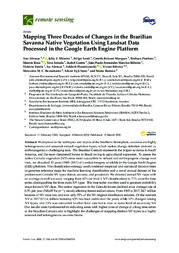Mapping Three Decades of Changes in the Brazilian Savanna Native Vegetation Using Landsat Data Processed in the Google Earth Engine Platform.
Mapping Three Decades of Changes in the Brazilian Savanna Native Vegetation Using Landsat Data Processed in the Google Earth Engine Platform.
Author(s): ALENCAR, A.; SHIMBO, J. Z.; LENTI, F.; MARQUES, C. B.; ZIMBRES, B.; ROSA, M.; ARRUDA, V.; CASTRO, I.; RIBEIRO, J. P. F. M.; VARELA, V.; ALENCAR, I.; PIONTEKOWSKI, V.; RIBEIRO, V.; BUSTAMANTE, M. M. C.; SANO, E. E.; BARROSO, M.
Summary: Widespread in the subtropics and tropics of the Southern Hemisphere, savannas are highly heterogeneous and seasonal natural vegetation types, which makes change detection (natural vs. anthropogenic) a challenging task. The Brazilian Cerrado represents the largest savanna in South America, and the most threatened biome in Brazil owing to agricultural expansion. To assess the native Cerrado vegetation (NV) areas most susceptible to natural and anthropogenic change over time, we classified 33 years (1985?2017) of Landsat imagery available in the Google Earth Engine (GEE) platform. The classification strategy used combined empirical and statistical decision trees to generate reference maps for machine learning classification and a novel annual dataset of the predominant Cerrado NV types (forest, savanna, and grassland). We obtained annual NV maps with an average overall accuracy ranging from 87% (at level 1 NV classification) to 71% over the time series, distinguishing the three main NV types. This time series was then used to generate probability maps for each NV class. The native vegetation in the Cerrado biome declined at an average rate of 0.5% per year (748,687 ha yr?1), mostly affecting forests and savannas. From 1985 to 2017, 24.7 million hectares of NV were lost, and now only 55% of the NV original distribution remains. Of the remnant NV in 2017 (112.6 million hectares), 65% has been stable over the years, while 12% changed among NV types, and 23% was converted to other land uses but is now in some level of secondary NV. Our results were fundamental in indicating areas with higher rates of change in a long time series in the Brazilian Cerrado and to highlight the challenges of mapping distinct NV types in a highly seasonal and heterogeneous savanna biome.
Publication year: 2020
Types of publication: Journal article
Unit: Embrapa Cerrados
Keywords: Cerrado, Desmatamento, Floresta, Pastagem
Observation
Some of Embrapa's publications are published as ePub files. To read them, use or download one of the following free software options to your computer or mobile device. Android: Google Play Books; IOS: iBooks; Windows and Linux: Calibre.
Access other publications
Access the Agricultural Research Database (BDPA) to consult Embrapa's full library collection and records.
Visit Embrapa Bookstore to purchase books and other publications sold by Embrapa.

